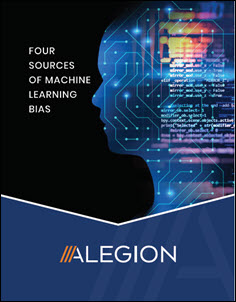Artificial intelligence. Machine learning. It’s easy to consider sectors such as this free of bias, as not much is these days. But that might not be the case. According to a new report from Alegion, AI bias is in fact a reality, and often one that is hard to avoid.

Download the full report.
A new white paper from the company that specializes in these areas asserts that since AI exists as a combination of algorithms and data, it’s not immune to bias. Why? There can be easily be bias in both algorithms and data.
Alegion is fully aware of potential AI bias because as they produce AI training data, the company is on the lookout for biases that can influence machine learning.
Through the company’s research, it has discovered what it calls four “distinct kinds of bias” that data scientists and AI developers need to be on the lookout for. The report explores these four potential AI biases and covers ways to decrease their impact on your machine learning systems.
First up, the new report touches on algorithm bias, which incidentally has nothing to do with data. According to Alegion, when dealing with machine learning algorithms, bias refers to “an over-simplification in a learned model,” also known as model insensitivity.
The report explains, “Data scientists try to find a balance between a model’s bias and its variance, another property that refers to the sensitivity of a model to variations in the training data.”
Next up, Alegion touches on sample bias, which occurs when the data used to train the model doesn’t accurately represent the problem space the model will operate in. The report points out that although mitigating sample bias is well understood across areas like psychology and social sciences, the practices are less discussed and utilized in the sectors of computer science and machine learning. Of course, this will have to change if these industries want to address and eradicate AI bias as much as possible.
Prejudicial bias is one that will be more familiar for readers, as it covers the cultural and potentially political issues that live outside of automation.
Prejudicial bias occurs when training data content is influenced by stereotypes or prejudice coming from the population. — Alegion
Businesses have to be careful to not let their models learn outputs that represent their developers’ prejudices.
Lastly, the report covers the fourth potential AI bias — found in measurement. This type of bias is a result of faulty measurement, which Alegion shared can lead to a systematic distortion of all data. But as with all bias, there are established ways for avoiding measurement bias. For example, Alegion points out, it’s a good idea to compare the outputs of different measuring devices.
When considering the potential for AI bias, it is important to remember, AI models and algorithms are still built by humans, therefore leaving room for human error and bias. It is important in some cases to utilize outside assistance, as well as ensure all labeling and annotation workers are trained to mitigate these potential issues before they are put to work on real data.
Download the new white paper from Alegion, “Four Sources of Machine Learning Bias,” that explores the four sources of AI bias, and how to mitigate these challenges for your AI systems.




Speak Your Mind